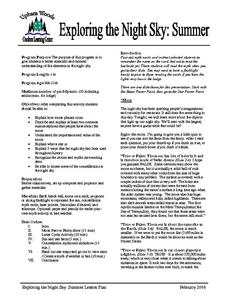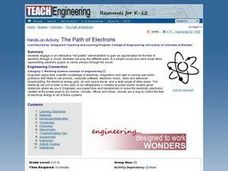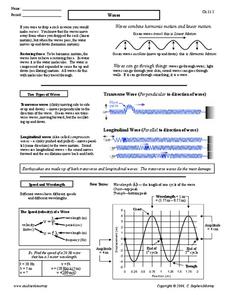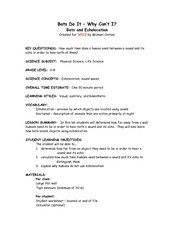North American Montessori Center
Sun and Moon Autumnal Equinox Activities
Two hands-on activities celebrate the sun and moon autumnal equinox. First, scholars create a cairn using a shoebox, flashlight, and drawing tools to view the sun's progression. Second, learners take to the kitchen to bake mooncakes...
Curated OER
Fermi Observatory Measures the Lumps in Space
In this gamma-ray worksheet, students read about the Fermi Gamma-ray Observatory and how it measures the invisible lumps in space. Students solve 3 problems using an equation to determine the time that gamma-rays travel in space and the...
Curated OER
Exploring the Night Sky: Summer
Students explain how moon phases occur. They describe and explain at least two common misconceptions that people have about the moon. Students explain what a star is. They explain 3 ways that the night sky has been used throughout history.
Curated OER
Measuring Speed in the Universe
In this measuring speed in the universe activity, students use photographs of 3 astronomical phenomena including supernova explosions, coronal mass ejections and solar flare shock waves to find how fast they move. The photographs show...
Curated OER
Circuits and Symbols
In this circuits worksheet, students read how electricity flows through circuits and learn how to draw a circuit diagram. Students then complete 16 matching, 2 multiple choice, 14 fill in the blank, and 3 short answer questions.
Curated OER
On the Oregon Trail
Learners work with primary documents and latter-day photographs to recapture the experience of traveling on the Oregon Trail. Working in groups, they write a scene for the movie that is historically accurate and based on the kinds of...
Curated OER
Falling into a Black Hole
In this black hole activity, students solve 3 problems given the equation used to determine the speed of a falling body using its mass, the constant of gravitation and the distance it will travel.
Curated OER
Gazing At Cosmic Pinballs
Students explore the world of stars. They see that the color of a star tells how hot or cold it is, that stars come in different sizes. and that stars are moving through space. They draw lines connecting start to star.
Curated OER
Coronal Mass Ejections
In this coronal mass ejections worksheet, students observe a time line of events that took place during a solar storm. Students use the time line to answer 3 questions about the solar storm and the time it took to reach Earth. Students...
Curated OER
Strange Sounds
Learners investigate sound as a form of energy. In this energy, forces, and sound lesson plan, students explore how different sounds may be made as they make a variety of materials vibrate. Learners observe the effects of vibrations and...
Curated OER
Mixing Colors
Young scholars understand why we see various colors. In this mixing colors lesson, students experiment with different food coloring to explore how colors are made. Young scholars record on a data sheet the colors they see.
Curated OER
Physical Geography of Africa
Fifth graders investigate the topography of Africa. In this physical geography lesson, 5th graders research the six regions of Africa and complete a physical map. Students locate various landforms in Africa. Students...
Curated OER
Using Models to Communicate
In this models worksheet, students read about how models are used to communicate events or principles in science. They are given an example and answer 4 questions about models. They discuss accuracy and inaccuracy of models. They create...
Curated OER
The Path of Electrons
Young scholars engage in an interactive "hot potato" demonstration to gain an appreciation for the flow of electrons through a circuit. They role play the different parts of a simple circuit and send small items representing electrons...
Curated OER
MAPPING THE TOPOGRAPHY OF UNKNOWN SURFACES
Students describe in words and graphic displays the elevation or depression profile of sections of Mars' Olympus Mons and/or Valles Marineris. They explain how orbiting spacecraft build up global maps one data slice at a time.
Curated OER
Secrets of Making Money
Students examine the properties of different materials used to make paper money. They design their own bill and share it with the class. They also watch a video clip and read an article about making money and how it affects the economy.
Curated OER
Waves
In this waves worksheet, students read about the different types of waves and how the speed of waves is calculated. Then students complete 5 matching, 8 fill in the blank, and 9 short answer questions.
Curated OER
The SUV Gas Problem
In this algebra learning exercise, students calculate the cost of gas based on miles driven in a SUV. They calculate how long it takes to recover a certain percent of gas mileage. There is an answer key.
Curated OER
Black Hole Power...X
In this power of black holes worksheet, high schoolers solve 6 problems including finding the surface area of a black hole, determining the amount of matter in the black hole shell, finding the rest mass energy and determining the time...
Curated OER
Black Holes...Hot Stuff!...VIII
In this black holes worksheet, students solve three problems about black holes using given equations for determining the temperature of the gases in a black hole and the visible light from the black hole at given temperatures.
Curated OER
Bats Do It-Why Can't I?
Students explore echos and how they are utilised in navigation. In this sound lesson students calculate the amount of time between a sound and its echo.
Curated OER
Electron Microscope
In this microscope worksheet, students use an on line site to answer questions about how a Scanning Electron Microscope works. They also conduct a virtual microscope activity where they view ten specimens and identify what each is.
Curated OER
Plant and Animal Changes
Second graders listen as the book, "What Do Animals Do In Winter?" is read to the class. They discuss that during the winter, some animals migrate, hibernate, hide, change color, and some make changes in their bodies like growing extra...
Curated OER
Why Do We Have Night?
Young scholars engage in a fun, creative way to discover how the Earth moves. This lesson helps students explain why there is day and night. It can also create curiosity to further study the solar system and eclipses!

























